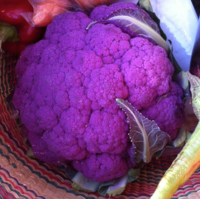
Photo from wikipedia
Tomato is a widely distributed, cultivated, and commercialized vegetable crop. It contains antioxidant constituents including lycopene, tocopherols, vitamin C, γ-aminobutyric acid, phenols, and flavonoids. This study determined the contents of… Click to show full abstract
Tomato is a widely distributed, cultivated, and commercialized vegetable crop. It contains antioxidant constituents including lycopene, tocopherols, vitamin C, γ-aminobutyric acid, phenols, and flavonoids. This study determined the contents of the antioxidant components and activities of the pulp with skin of ten regular, six medium-sized, and two small cherry tomato cultivars at red ripe (BR + 10) stage cultivated in Korea. The relationships among the Hunter color coordinates, the content of each component, and antioxidant activities were measured by Pearson’s correlation coefficients. As the a* value increased, the carotenoid and vitamin C contents increased, while the L* value, hue angle and tocopherol content decreased. As the b* value increased, the lycopene and total carotenoid contents decreased, and the flavonoid content in the hydrophilic extracts increased. The contents of vitamin C and total carotenoids including lycopene showed high positive correlations with the DPPH radical scavenging activities of both the lipophilic and hydrophilic extracts. Tocopherols and total phenolics in the hydrophilic and lipophilic extracts were not major positive contributors to the antioxidant activity. These findings suggest the quality standards for consumer requirements and inputs for on-going research for the development of better breeds.
Journal Title: Molecules
Year Published: 2022
Link to full text (if available)
Share on Social Media: Sign Up to like & get
recommendations!